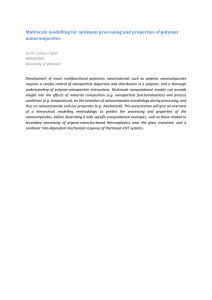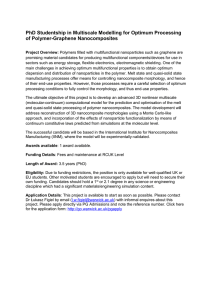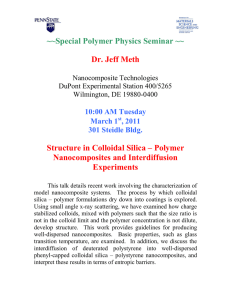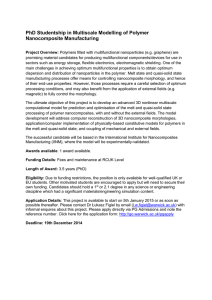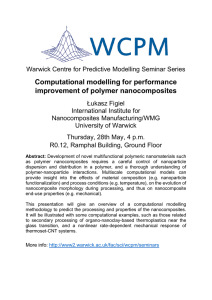High dielectric materials have been actively explored and used, because... material has potential for application in microwave communication devices, artificial
advertisement
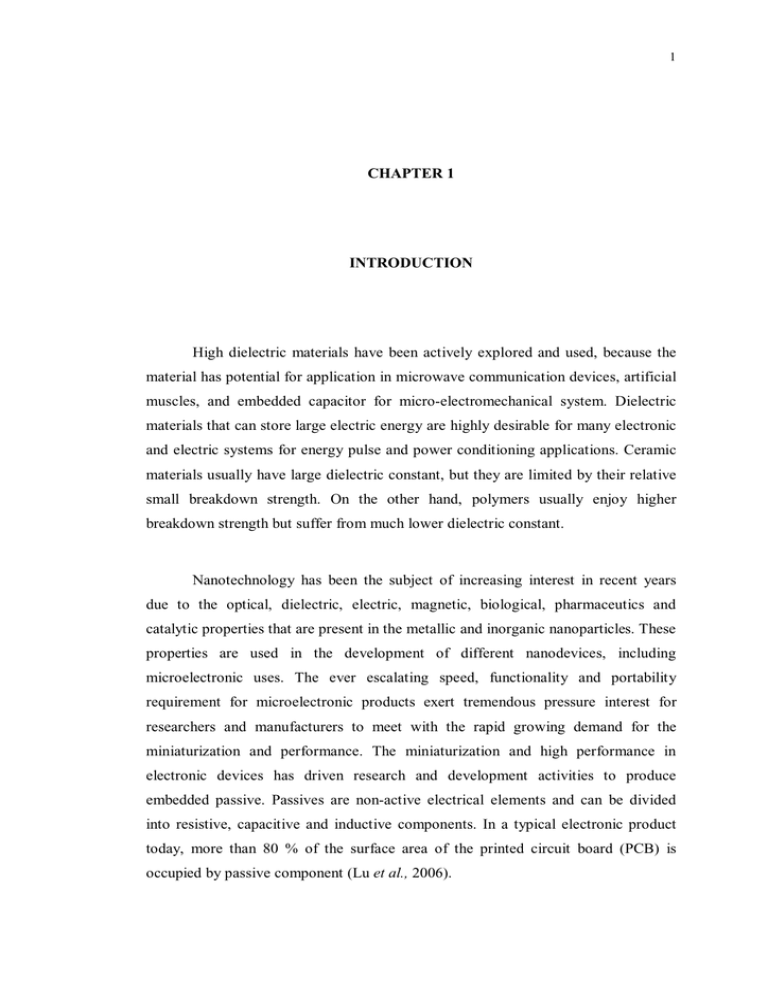
1 CHAPTER 1 INTRODUCTION High dielectric materials have been actively explored and used, because the material has potential for application in microwave communication devices, artificial muscles, and embedded capacitor for micro-electromechanical system. Dielectric materials that can store large electric energy are highly desirable for many electronic and electric systems for energy pulse and power conditioning applications. Ceramic materials usually have large dielectric constant, but they are limited by their relative small breakdown strength. On the other hand, polymers usually enjoy higher breakdown strength but suffer from much lower dielectric constant. Nanotechnology has been the subject of increasing interest in recent years due to the optical, dielectric, electric, magnetic, biological, pharmaceutics and catalytic properties that are present in the metallic and inorganic nanoparticles. These properties are used in the development of different nanodevices, including microelectronic uses. The ever escalating speed, functionality and portability requirement for microelectronic products exert tremendous pressure interest for researchers and manufacturers to meet with the rapid growing demand for the miniaturization and performance. The miniaturization and high performance in electronic devices has driven research and development activities to produce embedded passive. Passives are non-active electrical elements and can be divided into resistive, capacitive and inductive components. In a typical electronic product today, more than 80 % of the surface area of the printed circuit board (PCB) is occupied by passive component (Lu et al., 2006). 2 By eliminating surface mount components and embedding it into the substrate board, embedded passive component offer various advantages over traditional discrete ones, such as higher component density, increased functionality, improved electrical performance, increased design flexibility, improved reliability and reduced unit cost. The architecture of passive component is one area with room for improvement due to the large and growing number of passive component in today’s increasingly functional devices. Discrete passives, especially capacitors, have already become the major barrier of the electronic systems miniaturization. Therefore, the development of embedded passives is desired, if not required. Among passives component, the development of embedded capacitor has been an area of significant activity because the capacitor use in multiple functions, such as decoupling, by-passing, filtering, and timing capacitors (Rao and Wong, 2004; Lu et al., 2007). Figure 1.1 shows a schematic of embedded capacitance solution for electronic devices. High speed computing boards (Servers, router, super computers) Power distribution improvement Ultra-thin substrate (used as embedded capacitor) Copper Foil 8 – 24 micron Polymer dielectric Module board Cell phones, PDA, note book Miniaturization/HDI Hi-Dk RCF (used as embedded capacitor) Copper Foil 16 micron polymer dielectric with Hi-Dk filler Figure 1.1: Schematic representation of embedded capacitance solution for electronic devices 3 Studies polymer/ceramic and syntheses nanocomposites, of polymer nanocomposites, polymer/inorganic including nanocomposites and polymer/metal nanocomposites with high dielectric constant have been actively explored, with the hope to substantially enhance the electric energy density of the resulting nanocomposite. The utilized polymer nanocomposites for electronic application have many advantages such as light weight, shape-flexibility, cost effectiveness, and good process ability of the material. Many studies were developed to produce polymer nanocomposites with high dielectric constant. Polymer nanocomposites are appealing for two reasons. First of all, they possess large interfacial exchange coupling through a dipolar interface layer and leading to enhancement in polarization and polarizability in polymer matrix near the interface. As a result, enhanced dielectric constant can be expected in the polymer matrix near the interfaces. Secondly, the nanoscale particles also make it possible to reduce the thickness of polymer matrix film to nano range, and thus increase its already high breakdown strength even further by avoiding avalanche effect. Nanoparticles are generally categorized as the class of materials that fall between the molecular and bulk solid limits, with an average size between 1 – 100 nm. Semiconductor nanoparticles, referred to as quantum dots, with dimensions in the order of nanometers have been the subject of intense research in the past two decades, due to their unique optical, electronic, physical and chemical properties (Alivisatos, 1996; Wang and Herron, 1991). Inorganic materials on nano-sized metals and semiconductors provide a potential solution to meet present and future technological demand in virtue of the novel properties and unique property combination of both metal and semiconductor nanoparticles. On the other hand, uniform dispersion of nanoparticles in the nanocomposites is required because clumps of particles inside the polymer matrix will not lead to desirable electrical or dielectric properties. However, uniformly dispersed ultrafine particles in polymer matrix may not be easily achieved by incorporating pre-made nano-size particles into a polymer. This is caused by the easy agglomeration of nanoparticles and high viscosity of polymers. The most promising way to decrease an obstacle of these 4 factors on the dielectric properties of nanocomposites is the in-situ or direct formation of nanoparticles in polymer matrix. The focus of this study is to synthesize CdS/polymer nanocomposites and characterization of the physicochemical and electrical properties. The materials were synthesize by in-situ polymerization and ion exchange-precipitation method. The nanocomposites were carried out by several techniques such as UV – Vis spectroscopy, UV - Vis Diffuse Reflectance (UV – Vis DR) spectroscopy, Fourier Transform Infrared (FTIR) Spectroscopy, X-ray Diffraction (XRD), Atomic Absorption Spectroscopy (AAS), Thermogravimetry Analysis (TGA), Transmission Electron Microscopy (TEM), Field Emmision Scanning Electron Microscopy (FESEM), AC Impedance Analyzer, and Thermal Conductivity Analyzer. The used of CdS nanoparticles as nanofiller have received great attention because of their unique electrical and optical properties. The selected approach of synthesis methods and the intrinsic of chemical properties of selected polymers will be produced on nanoscale CdS by encapsulated within polymer and attached on polymer matrices. The combination of CdS nanoparticles and the polymer have developed a CdS/polymer nanocomposite with a high dielectric constant and improved physicochemical properties. 1.1 Background of Study Many researchers have developed methods for synthesis of high dielectric properties polymer nanocomposites. The first approach process for enhancing the dielectric constant of a polymer nanocomposites is to disperse a high dielectric constant insulating ceramic (ferroelectric materials), namely nanoceramic using barium titanate (BaTiO3) (Devaraju et al., 2005; Pant et al., 2006), lead titanate (PbTiO3), lead zirconate titanate (PZT) (Dong et al., 2006), strontium titanate (SrTiO3) (Prijamboedi et al., 2005), into polymers. In order to obtain a high value of 5 dielectric constant, large amount of the filler has to be loaded into polymer matrix, resulting in loss of flexibility and inhomogeneous nanocomposites. The second approach to obtain high dielectric constant polymer nanocomposites was achieved by dispersing conductive fillers into polymers. The common conductive materials used to produce the polymer nanocomposites are carbon nano-fibers, metals such as silver (Ag) nanoparticles (Lu et al., 2006), aluminium (Al) and nanoparticle aluminium (Xu and Wong, 2007), cadmium oxide (CdO) (Pant et al., 2006), zink sulfide (ZnS) (Ghosh et al., 2005b), polymers such as polyaniline (PANI) (Lu et al., 2007), and organic acids such as sulfamic acid (Ameen et al., 2007) and copper pthalocyanine. The polymer nanocomposites have successfully increased the dielectric constant of the polymer. The increased dielectric constant observed in such composites arises from conducting particles isolated by very thin dielectric layers to form micro-capacitors. However, the dielectric loss is very high and difficult to control, because the particles can easily form a conductive path in the composite as the filler concentration nears the percolation threshold. The third approach to increase dielectric properties of polymer was to utilize an inorganic and organic materials such as, titanium oxide (TiO2) (Li et al., 2006; Yang and Kofinas, 2007; Mo et al., 2008; Dey et al., 2004), aluminium oxide (Al2O3) (Li et al., 2007), clay (Zhang et al., 2005), zinc oxide (ZnO2) (Hong et al., 2005) and also other polymers such as poly(trimethylene terephtalate) (PTT) (Kalakkunnath and Kalika, 2006). The results showed that the dielectric constant of the polymer did not increase significantly. The challenge to produce dielectric polymer nanocomposites relies on the ability to manipulate the fraction, characteristic length, and arrangement of dielectric component inside the engineered nanocomposites. No systematic studies to date have been published on the influence of effective volume fraction, characteristic length, and arrangement of dielectric components on the effective dielectric constant of the composites. This is due the intrinsic incompatibility between inorganic particles and organic matrices. Most of the previous studies have utilized the conventional method of blending a high dielectric constant material into polymer, which has no real 6 control on particles size and distribution within the polymer matrix (Yang and Kofinas, 2007). The study, synthesis and characterization of semiconductor nanoparticles have attracted intense research lately owing to the unique chemical and physical properties of the nanoparticles and also the vast potential for practical application of the composite system incorporating the nanoparticles. Semiconductor nanoparticles have physical and chemical properties that may differ significantly from those of the bulk material. Such deviations are attributed to the small particle size and the accompanying surface structure effects. By controlling the particle size and surface structures of the semiconductor materials, electronic, optical, magnetic, mechanical, and chemical properties can be modified to suit a wide range of device application in various fields (Zhao et al., 2001). Semiconductor nanoparticles have interesting applications in electronic, optical, electro-optical devices, catalysis (Yanagida et al., 1990; Graetzel and Graetzel, 1979), and optics (Wang, 1991). More particularly, cadmium sulfide (CdS) nanoparticles have made a great impact in applications including pigments, battery, optoelectronic devices, photocatalyst (Yanagida et al., 1990; Graetzel et al., 1979; Hirai et al., 2002a, 2001, Hirai and Bando, 2005 and Yang, 2005), photosensitive matrices, and resistor for light detecting laser. Dielectric properties of CdS nanoparticles and bulk CdS have also been studied and reported (Zhou, 2003; Tiwari and Tiwari, 2006). Polymers as matrices have several advantages for producing CdS nanoparticles and CdS/polymer nanocomposites. On the other hand, polymers with a type of spatial conformation can be used as template to make nanoparticles in solution with narrow size distribution and uniform confinement throughout their periodic micro-domain. Besides that, polymers are able to achieve surface passivation, prevent particles from agglomeration and maintain the particles degree of dispersion of particle, which are well-known for their ability in controlling the particle size and size distribution effectively (Yang et al., 2003). 7 Based on these above explanations and reasons, studies on the synthesis, characterization, and elucidation of the dielectric and electrical properties of CdS/polymer nanocomposites are undertaken to develop a high dielectric constant material. The CdS/polymer nanocomposites were synthesized by combining several methods i.e. in-situ polymerization, ion exchange and precipitation. The polymer matrices employed are poly(styrene-divinylbenzene) [P(S-DVB)], poly(methacrylic acid-ethyleneglycol dimethacrylic acid) [P(MAA-EGDMA)] and sulfonated poly(styrene-divinylbenzene) [SO3H-P(S-DVB)]. 1.2 Design and Strategy of Research The synthesis strategy for preparation of high dielectric constant CdS/polymer nanocomposites with selected polymer matrices is shown schematically in Figure 1.2. In this study, the CdS/polymer nanocomposites were synthesized using three kinds of polymer i.e. P(S-DVB), P(MAA-EGDMA) and SO3H-P(S-DVB). Polystyrene and polymethacrylic acid are common polymers used in preparation of encapsulated metal or metal oxide and solid phase extraction, respectively. The choice of the polymers is based on their different properties and degree of polarity. Among the polymers employed in the present study polystyrene has no functional group, polymethacrylic acid has a weak acid functional group (COOH), while sulfonated-polystyrene has a strong acid functional group (-SO3H). Based on the different chemical properties of the polymers, hence different procedure of synthesis was applied in order to disperse CdS nanoparticles on the polymer surface or encapsulated within the polymer matrix. 8 Nano/micron polymer matrix CdS nanoparticles Intramolecular interaction Intermolecular interaction CdS/polymer nanocomposites with high dielectric constant Figure 1.2: Schematic representation of the synthesis of CdS/polymer nanocomposites In this study, CdS/poly(styrene-divinylbenzene) [CdS/P(S-DVB)] nanocomposites were synthesized by in-situ polymerization in miniemulsion system. First, the CdS nanoparticles were prepared by reverse micelles in miniemulsion system using CTABr as the surfactant, styrene-divinyl benzene as the oil-phase, 2propanol as the co-stabilizer, and also water. While, the CdS/poly(methacrylic acidethyleneglycol dimethacrylic acid) [CdS/P(MAA-EGDMA)] nanocomposites were synthesized by combination of three methods i.e. in-situ polymerization to produce P(MAA-EGDMA) nanoparticles, ion exchange and precipitation process to produce CdS/P(MAA-EGDMA) poly(styrene-divinyl nanocomposites, respectively. The CdS/sulfonatedbenzene) [CdS/SO3-P(S-DVB)] nanocomposite were synthesized by combining four methods i.e. in-situ polymerization to produce P(SDVB) nanoparticles, sulfonation reaction with fuming sulfuric acid (H2S2O7) to 9 produce SO3H-P(S-DVB), ion exchange and precipitation processes to produce CdS/SO3-P(S-DVB) nanocomposites, respectively. 1.3 Objective of The Study The main goals of this research are to synthesize, characterize and evaluate the dielectric and electrical properties of the CdS/polymer nanocomposites. The objectives of the research are: 1. To synthesize and characterize CdS nanoparticles prepared by reverse micelles in miniemulsion system using monomer as the oil-phase 2. To synthesize and characterize pure P(S-DVB) and P(MAAEGDMA) prepared by in-situ polymerization in miniemulsion system. 3. To synthesize and characterize CdS/P(S-DVB) nanocomposites prepared by in-situ polymerization in miniemulsion system using monomer as the oil-phase 4. To synthesize and characterize CdS/P(MAA-EGDMA) nanocomposites prepared by ion exchange and precipitation processes. 5. To synthesize and characterize CdS/SO3-P(S-DVB) nanocomposites prepared by sulfonation reaction, ion exchange and precipitation processes. 6. To evaluate and to compare the dielectric properties, electrical properties, thermal properties and thermal conductivity of these CdS/polymer nanocomposites. 1.4 Scope of The Study The scope of the study is focused on the following aspects i.e. synthesis of CdS nanoparticles, synthesis of pure P(S-DVB) and P(MAA-EGDMA), preparation 10 of CdS/P(S-DVB) nanocomposites, preparation of CdS/P(MAA-EGDMA) nanocomposites, preparation of CdS/SO3-P(S-DVB) nanocomposites, and evaluation of dielectric properties, electrical properties, thermal properties and thermal conductivity. Table 1.1: Outline of results and discussion Outline of results and discussion CdS/P(S-DVB) nanocomposites • Section in chapter 4.1 Optimization of CdS synthesis and synthesis of CdS/P(S-DVB) • Physicochemical properties of CdS/P(S-DVB) • Dielectric properties of CdS/P(S-DVB) CdS/P(MAA-EGDMA) nanocomposites • Physicochemical properties of CdS/P(MAA-EGDMA) • Dielectric properties of CdS/P(MAA-EGDMA) CdS/SO3-P(S-DVB) nanocomposites • Physicochemical properties of CdS/SO3HP(S-DVB) • Dielectric properties of CdS/SO3-P(S-DVB) Comparison of physicochemical and electrical 4.2 4.3 4.4 properties of CdS/polymer nanocomposites This research involves the synthesis of CdS nanoparticles by reverse micelles in miniemulsion using styrene-divinyl benzene as oil-phase, followed by the synthesis and characterization of CdS/P(S-DVB) nanocomposites via in-situ polymerization in the miniemulsion system. The miniemulsion system is prepared using CTABr as surfactant, monomer as oil-phase, 2-propanol as co-stabilizer and water. The formation, stabilization and particle size of CdS nanoparticles in the miniemulsion system were characterized using UV – Vis spectroscopy. Outcomes of this work are reported in Chapter 4. Chapter 4 also reports the synthesis and characterization of dielectric properties of CdS/P(MAA-EGDMA) nanocomposites 11 and observation on the preparation and characterization of dielectric properties of CdS/SO3-P(S-DVB) nanocomposites. The outline of the results and discussions section are shown in Table. 1.1. Chapter 5 presents the conclusions of the synthesis, characterization and dielectric properties of all the nanocomposites of the prepared CdS/polymer nanocomposites.
